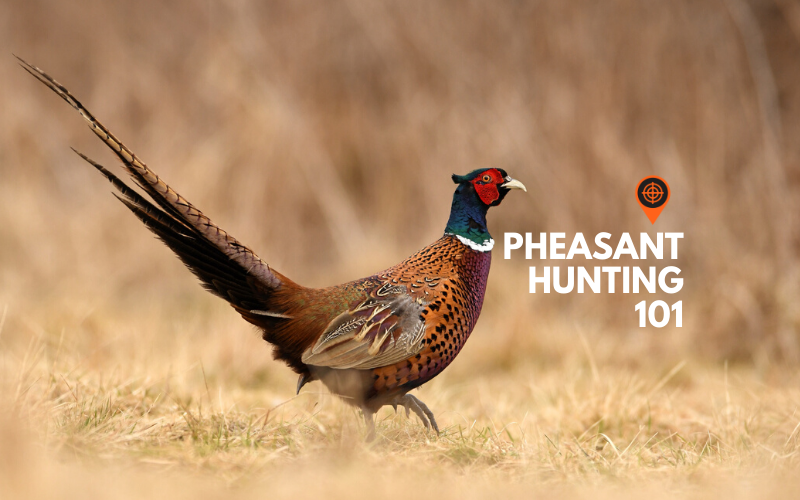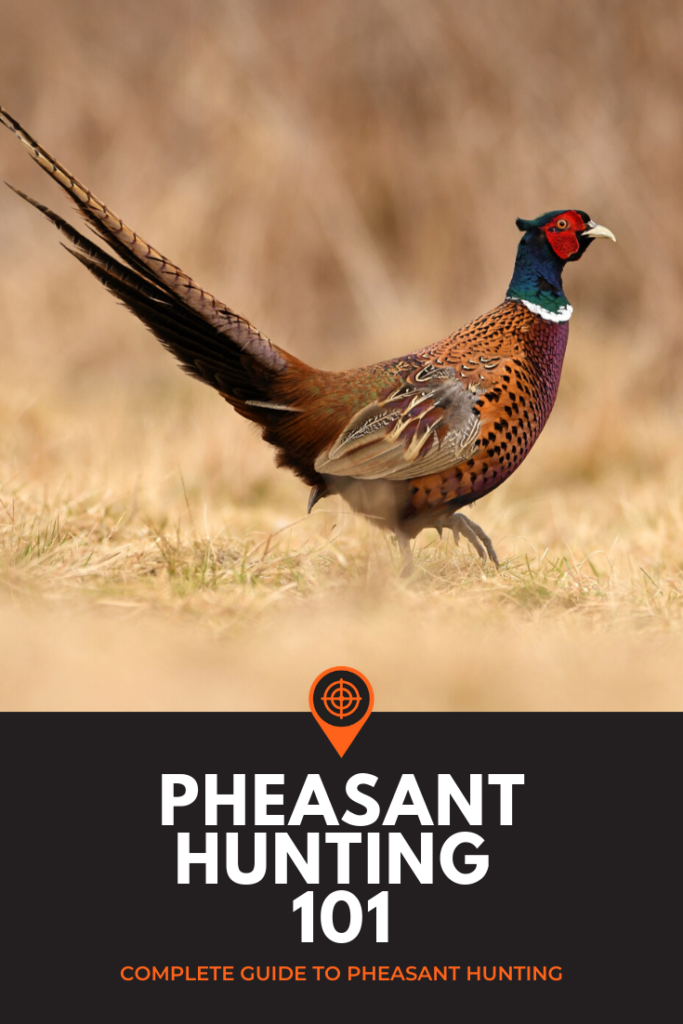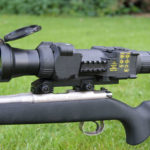Pheasant Hunting
Pheasant hunting is one of the most widely enjoyed outdoor activities in the United States—and for good reason. Upland male pheasants are well-known for their long tail and vibrant coloration. Pheasant hunting should be on every serious bird hunter’s bucket list, but one decent pheasant hunting trip is more than enough to get most outdoorsmen and women coming back for more.
There are many positives about pheasant hunting and why so many hunters enjoy going after this game bird. Instead of being required to sit still for hours at a time, pheasant hunters enjoy the hunt on foot with well-trained dogs while taking in the beauty of the open plains of the Midwest.
Considered to be one of the most beautiful bird species in the world, pheasants are native to Asia. The ring-necked birds were first introduced to the North American Content in the late 1800’s in Oregon. It’s difficult to estimate just how many pheasants there are in the United States, but the species can be found everywhere from Maine to Montana.
Pheasant Hunting might appear fairly simple at first glance, but there are some specific points to understand before going afield for your first pheasant hunting trip. We’ve compiled this article that can serve as a pheasant hunting guide for both beginners and seasoned outdoorsmen.
Understand the Pheasant Species
The best starting point for anyone planning their first pheasant hunting trip is to become as knowledgeable with this particular bird species as you can. Pheasants prefer to stay in low to medium-height grass that is near a water source. They can also be found in and around fallen trees which help give them extra cover and protection from predators.
Mornings are typically better for pheasant hunting as the birds are often hanging out in the low grass searching for food. Birds will usually become active again later in the evening.
Pheasant hunting in colder weather can still be successful, even when there’s some snow on the ground. Snow will drive pheasants to seek more dense cover, but don’t let this stop you from going afield.
Hunt with a Good Dog
One of the most enjoyable things about pheasant hunting—for many hunters—is the chance to share your hunting trip with a dog. Bird dogs are a sight to behold in the field when they are going after pheasants.
Having a well-trained dog makes a big difference as to how many birds you’ll get a shot at during your pheasant hunting trip. Hunting with man’s best friend is an experience like no other. Dogs have so much enthusiasm for hunt that it’s clear to see many breeds were practically born to hunt.
You can have success hunting pheasants without a dog and simply stalking them on foot, but a dog will be able to use their senses to locate birds and also help you find them after they’ve been shot.
Choose the Right Gear
Which gun should you use? You could potentially hunt with a variety of different shotguns and still get a limit of birds.
According to many pheasant hunting experts, a 12 gauge shotgun is hard to beat as far as the all-around effectiveness when pheasant hunting. A 16 gauge would also be a good fit, and a 20 gauge might be ideal for younger hunters or ladies that need a lighter kick.
Keep in mind, you’re likely to walk several miles on a full day’s pheasant hunting trip. Carrying a lightweight shotgun can make a big difference in comfort and accuracy, especially when you’re traveling up and down hills during your hunt.
You’ll also want to tailor your shot load to how the birds in your area are behaving. If you’re able to walk right up on pheasants and they are flushing close to you, go with a 6 or 7 ½ shot load. These loads have more pellets and better knockdown power at close range.
Are you hunting birds that flush quick and fly fast? Go with a 4 or 5 shot load that will help you reach out and get those pheasants that might otherwise force you to waste shells.
Lastly regarding guns and shells—a modified or improved modified choke is usually best for pheasant hunting.
The Right Kind of Clothing
The most important thing to remember when planning your pheasant hunting trip is to go with comfortable clothing that’s highly visible to those around you.
If your pheasant hunting trip is earlier in the season on a warm day, don’t wear clothes that are too thick as this will just cause you to sweat more and have trouble cooling off. If you’re hunting on a cold day, it’s fine to wear extra layers, but make sure you don’t wear so many shirts and jackets that your aiming ability is hampered.
Select pants that will protect your lower body from thorns or other bushes that might rip and tear your britches. Pheasants seem to find a way to fly into the thickets brush after they’ve been shot, so be prepared to go into any type of terrain to retrieve your bird—especially if you don’t have a dog to do that part for you.
Lastly, make sure you wear orange. Hunting accidents can happen with the most experienced outdoorsmen, and wearing orange could save your life and avert serious injury.
Scout for Pheasant Signs
Doing your homework before hunting a piece of property will pay off big dividends later in the actual hunt.
When driving around your hunting spot, be sure to keep an eye out for pheasants all around you. Look for corn as this crop seems to be a favorite of pheasants. Anywhere you can find corn with plenty of suitable cover near water, you’re almost garaunteed to find pheasants nearby.
Hunt as a Team
Pheasant hunting is unique compared to other game animals in that hunters can join one another in groups and have better success than just hunting alone with a dog.
Hunting in a group allows you to cover more ground and get more shots on flushed birds. Walking in a line nearly 20 yards apart is an ideal way to have a great pheasant hunting trip. This will help keep those ringnecks in front of you and make sure your dogs are hunting forward instead of backwards.
No Hurry
Pheasant hunting, like almost every other form of hunting, is best done slowly and methodically. Rushing through a field will open the possibility of passing by pheasants without ever even knowing it.
Work the field in a zig-zag pattern and take your time when you come upon some cover that looks like it would hold birds. There’s no need to rush your pheasant hunting trip. Take your time and enjoy the hunt.
Believe it or not, lots of pheasants will run on foot to escape danger instead of flushing. This is sometimes due to heavy hunting pressure and the realization that flushing will often be followed by gunshots.
Keep it Simple and Stick to Obvious Pheasant Hideouts
Pheasant hunting is only tough if you want it to be. Most pheasant hunting enthusiasts will attest to the value of sticking to those parts of a property that you just can’t miss.
Hedgerows offer plenty of cover for pheasants and feature a long, unbroken line of places to hide from predators. Ditches are also prime targets for pheasants looking to blend in the with their natural surroundings.
Pay attention to where pheasants fly to and light after you miss a shot as they are likely headed to a spot where other birds can be found.
Be Stealthy and Patient
Many first-time pheasant hunters are surprised to find out just how clever these birds actually are.
Don’t assume that pheasants are like other game birds and that you can make as much noise as you want. Staying quiet while pheasant is one of those tips you’ll hear from all the old timers who know the best bird hunting secrets.
Underestimating this bird species could lead to a humbling experience. Do plenty of research on the specific area you plan to hunt and don’t be afraid to ask some of the locals what advice they might have for anyone looking to bag some ringnecks.
Plan Accordingly
Once you’ve gathered the necessary gear and done your research, you’ll be better off choosing between some of the absolute best pheasant hunting locations in the United States.
There are plenty of places throughout the upper and lower midwest to find great spots for pheasant hunting, but don’t try to do it yourself on the first go unless you are very confident in your skills or you have an experience hunting buddy.
Hiring a pheasant hunting guide is often a great way to get a hands-on education seminar on Pheasant Hunting 101. Book a trip with a reputable guide who’s been pheasant hunting for many years and be sure to ask plenty of questions. These guides almost always love sharing their tips and tricks for pheasant hunting with beginners and you can really come away with a wealth of knowledge in the sport.










